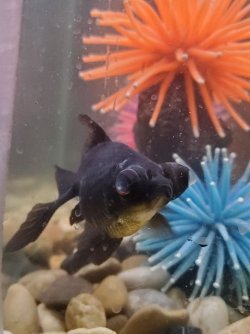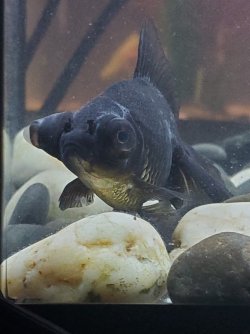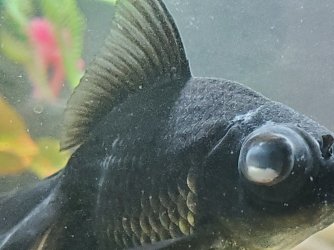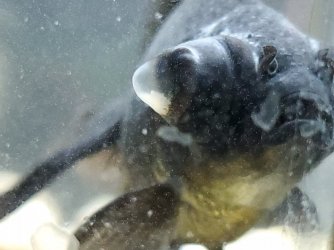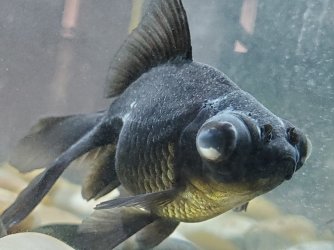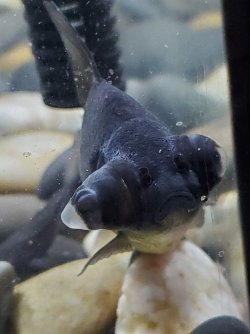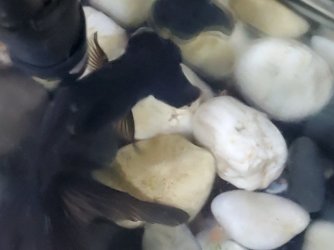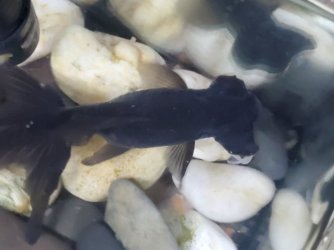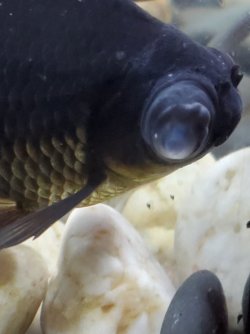I don't know what to do, my black moor was initially quarantined for popeye(which looks to be gone now) but before the quarantine I noticed this small red streak in her other eye. I've been using test strips, Melafix, Kanaplex, and doing salt baths for the past 2 weeks(stopped salt dips last Thursday on the 26th). She's being housed in a 10 gallon tank for temporary quarantine, she's usually in a 50 gallon with a fancy goldfish and common pleco. Test stips came out optimal for everything. She's been swimming around just fine, but I have to go to school throughout the day and am not sure about her eating habits now. Please, what do I do and if needed what should I get?
You are using an out of date browser. It may not display this or other websites correctly.
You should upgrade or use an alternative browser.
You should upgrade or use an alternative browser.
Help, my black moor has something in her eye!
- Thread starter Mari9807
- Start date
G
Guest14017
Guest
You need an API Master Test kit first. Test strips are not accurate at all. She looks as if she is scraping herself on things. I see a few other bits on her that appear to be healing. Fancy goldfish, especially telescope eye types... need tanks free of sharp decorations so they don't hurt themselves. A few weeks of salt and clean water usually clears this up.
The common pleco needs to go. He will outgrow the tank and they have a reputation of latching onto the sides of slower moving fish like fancies as they sleep... and sucking at their slime coats, causing wounds and stress and eventually death.
The common pleco needs to go. He will outgrow the tank and they have a reputation of latching onto the sides of slower moving fish like fancies as they sleep... and sucking at their slime coats, causing wounds and stress and eventually death.
Last edited by a moderator:
Stop adding things unless you know what the problem is.
The fish is covered in excess mucous (the cream patches). This is normally caused by something in the water irritating the fish.
The white thing in the eye could be damage or a parasitic worm that got lost.
How long has the eye had the white bit in it?
Can you post some more pictures of that eye?
---------------------
Check the water quality for ammonia, nitrite, nitrate and pH.
Wipe the inside of the glass down with a clean fish sponge.
Do a 75% water change and gravel clean the substrate every day for a week. The water changes and gravel cleaning will reduce the number of disease organisms in the water and provide a cleaner environment for the fish to recover in.
Make sure any new water is free of chlorine/ chloramine before it is added to the tank.
Clean the filter if it hasn't been done in the last 2 weeks. However, if the filter is less than 6 weeks old, do not clean it. Wash the filter materials/ media in a bucket of tank water and re-use them. Tip the bucket of dirty water on the garden/ lawn.
Increase surface turbulence/ aeration to maximise the dissolved oxygen in the water.
Add some salt, (see directions below).
---------------------
SALT
You can add rock salt (often sold as aquarium salt) or swimming pool salt to the aquarium at the dose rate of 1 heaped tablespoon per 20 litres of water. If there is no improvement after 48 hours you can double that dose rate so there is 2 heaped tablespoons of salt per 20 litres.
Keep the salt level like this for at least 2 weeks but no longer than 4 weeks otherwise kidney damage can occur. Kidney damage is more likely to occur in fish from soft water (tetras, Corydoras, angelfish, Bettas & gouramis, loaches) that are exposed to high levels of salt for an extended period of time, and is not an issue with livebearers, rainbowfish or other salt tolerant species.
The salt will not affect the beneficial filter bacteria, fish, plants, shrimp or snails.
After you use salt and the fish have recovered, you do a 10% water change each day for a week using only fresh water that has been dechlorinated. Then do a 20% water change each day for a week. Then you can do bigger water changes after that. This dilutes the salt out of the tank slowly so it doesn't harm the fish.
When you do water changes while using salt, you need to treat the new water with salt before adding it to the tank. This will keep the salt level stable in the tank and minimise stress on the fish.
The fish is covered in excess mucous (the cream patches). This is normally caused by something in the water irritating the fish.
The white thing in the eye could be damage or a parasitic worm that got lost.
How long has the eye had the white bit in it?
Can you post some more pictures of that eye?
---------------------
Check the water quality for ammonia, nitrite, nitrate and pH.
Wipe the inside of the glass down with a clean fish sponge.
Do a 75% water change and gravel clean the substrate every day for a week. The water changes and gravel cleaning will reduce the number of disease organisms in the water and provide a cleaner environment for the fish to recover in.
Make sure any new water is free of chlorine/ chloramine before it is added to the tank.
Clean the filter if it hasn't been done in the last 2 weeks. However, if the filter is less than 6 weeks old, do not clean it. Wash the filter materials/ media in a bucket of tank water and re-use them. Tip the bucket of dirty water on the garden/ lawn.
Increase surface turbulence/ aeration to maximise the dissolved oxygen in the water.
Add some salt, (see directions below).
---------------------
SALT
You can add rock salt (often sold as aquarium salt) or swimming pool salt to the aquarium at the dose rate of 1 heaped tablespoon per 20 litres of water. If there is no improvement after 48 hours you can double that dose rate so there is 2 heaped tablespoons of salt per 20 litres.
Keep the salt level like this for at least 2 weeks but no longer than 4 weeks otherwise kidney damage can occur. Kidney damage is more likely to occur in fish from soft water (tetras, Corydoras, angelfish, Bettas & gouramis, loaches) that are exposed to high levels of salt for an extended period of time, and is not an issue with livebearers, rainbowfish or other salt tolerant species.
The salt will not affect the beneficial filter bacteria, fish, plants, shrimp or snails.
After you use salt and the fish have recovered, you do a 10% water change each day for a week using only fresh water that has been dechlorinated. Then do a 20% water change each day for a week. Then you can do bigger water changes after that. This dilutes the salt out of the tank slowly so it doesn't harm the fish.
When you do water changes while using salt, you need to treat the new water with salt before adding it to the tank. This will keep the salt level stable in the tank and minimise stress on the fish.
About three days now since I've noticed that in her eye. I'll be getting that API Master Test kit and yes here are some more pictures(took before tank clean).Stop adding things unless you know what the problem is.
The fish is covered in excess mucous (the cream patches). This is normally caused by something in the water irritating the fish.
The white thing in the eye could be damage or a parasitic worm that got lost.
How long has the eye had the white bit in it?
Can you post some more pictures of that eye?
---------------------
Check the water quality for ammonia, nitrite, nitrate and pH.
Wipe the inside of the glass down with a clean fish sponge.
Do a 75% water change and gravel clean the substrate every day for a week. The water changes and gravel cleaning will reduce the number of disease organisms in the water and provide a cleaner environment for the fish to recover in.
Make sure any new water is free of chlorine/ chloramine before it is added to the tank.
Clean the filter if it hasn't been done in the last 2 weeks. However, if the filter is less than 6 weeks old, do not clean it. Wash the filter materials/ media in a bucket of tank water and re-use them. Tip the bucket of dirty water on the garden/ lawn.
Increase surface turbulence/ aeration to maximise the dissolved oxygen in the water.
Add some salt, (see directions below).
---------------------
SALT
You can add rock salt (often sold as aquarium salt) or swimming pool salt to the aquarium at the dose rate of 1 heaped tablespoon per 20 litres of water. If there is no improvement after 48 hours you can double that dose rate so there is 2 heaped tablespoons of salt per 20 litres.
Keep the salt level like this for at least 2 weeks but no longer than 4 weeks otherwise kidney damage can occur. Kidney damage is more likely to occur in fish from soft water (tetras, Corydoras, angelfish, Bettas & gouramis, loaches) that are exposed to high levels of salt for an extended period of time, and is not an issue with livebearers, rainbowfish or other salt tolerant species.
The salt will not affect the beneficial filter bacteria, fish, plants, shrimp or snails.
After you use salt and the fish have recovered, you do a 10% water change each day for a week using only fresh water that has been dechlorinated. Then do a 20% water change each day for a week. Then you can do bigger water changes after that. This dilutes the salt out of the tank slowly so it doesn't harm the fish.
When you do water changes while using salt, you need to treat the new water with salt before adding it to the tank. This will keep the salt level stable in the tank and minimise stress on the fish.
Attachments
Sorry can't tell what's in the eye. It's not meant to have white in it though ands the eye is protruding out, which is a bad sign.
You can try deworming the fish with Praziquantel. It might help but it might not.
You can try deworming the fish with Praziquantel. It might help but it might not.
G
Guest14017
Guest
I see no reason to use Prazi. Frankly the fish looks mostly okay. Her fins aren't clamped and the OP has not described any behavioral issues with the fish. The eye issue and the few bits I saw on her body looked like they had been scraped on something to me.
The abnormally sized eyes are typical with these fish. Often in poorly breed specimens, one eye gets WAY larger than the other and can look all sorts of deformed. The fish can also go blind in that eye. This is just genetics.
That sort of looks like a migrating "pearl" in her eye. I don't think anything will help it. I think it's best to just leave it alone. Put her in a clean tank and just watch her and see how things go. I see no need to medicate her at all.
The water in the tank looks very turbid/dirty so I would just ensure my water quality is good by getting and using an API Master Test Kit... and stop throwing medications at the fish. Clearly they aren't helping.
The abnormally sized eyes are typical with these fish. Often in poorly breed specimens, one eye gets WAY larger than the other and can look all sorts of deformed. The fish can also go blind in that eye. This is just genetics.
That sort of looks like a migrating "pearl" in her eye. I don't think anything will help it. I think it's best to just leave it alone. Put her in a clean tank and just watch her and see how things go. I see no need to medicate her at all.
The water in the tank looks very turbid/dirty so I would just ensure my water quality is good by getting and using an API Master Test Kit... and stop throwing medications at the fish. Clearly they aren't helping.
I got the API Master Test Kit and did all the tests, everything came out alright except there is a little bit of ammonia that I'm taking measures to lower. The medication had only been used to treat her popeye which is gone now and I haven't been using the medication for a few days now. I'm willing to try what I can since the other eye has progressed to get worse. I know her eyes weren't usually like that so I'm just assuming that there's something wrong(with the fact that it's looking worse). The eye looks to have started protruding forwardish.
Attachments
G
Guest14017
Guest
You should remove those river rocks firstly. They do nothing but trap debris and could be the root cause of the ammonia problem. She needs CLEAN water. Again I wouldn't medicate. Maybe some salt but that's it. Can you show a full view of the tank? To me the eye looks injured but it won't heal if she has ammonia etc in her water. And if you still have the pleco, he also could be attacking her at night which will make her worse.
Similar threads
- Replies
- 11
- Views
- 929
- Replies
- 8
- Views
- 751

